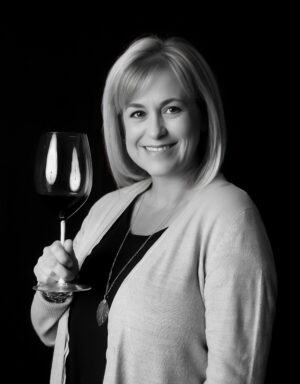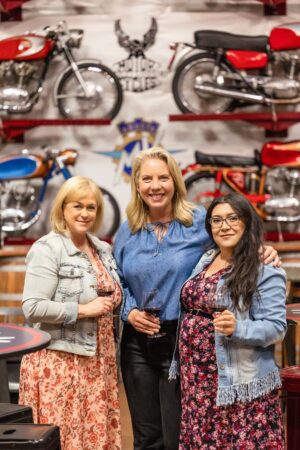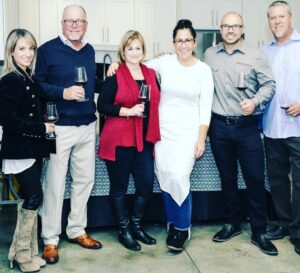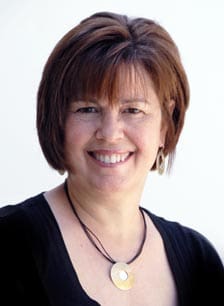By Laurie Wachter

“I’m a behind-the-scenes kind of gal,” says Krista Chaich, executive director of the Temecula Valley Winegrowers Association, adding that “I just do my work.” Yet Chaich’s impact on this growing wine region is what makes her one of 2024’s Most Inspiring People in the wine industry.
The Temecula Valley in Southern California wine country is a lot like Chaich: warm, welcoming and approachable while still being serious about its world-class wines. In 2007, when she started “doing her work” in the Temecula Valley, the valley was a small, relatively undiscovered and often maligned region.
“I have seen Krista’s leadership take the region from an emerging destination with a small budget in 2015 to a well-respected wine region that was named one of Wine Enthusiast Magazine’s top 10 wine travel destinations in the world,” says brand marketing partner Devin Parr.
From “can’t get no respect” to recognition
When Temecula Valley gained American Viticultural Area status in 1984, it had the backbone of a great wine region — a mild Mediterranean climate, grand mountainous vistas and the beginnings of vineyards taking advantage of its early growing season. It also held the promise of being a desirable destination for wine lovers, with several major Southern Californian population centers an easy drive away. However, realizing that potential took time and considerable effort.

Phil Baily, who opened Baily Vineyard & Winery in 1986, reflects on those early years. “Peter Poole, who ran Mount Palomar Winery for quite a few years, described Temecula Valley as the Rodney Dangerfield of the wine industry — it ‘can’t get no respect!’ When you’re a new region just starting out, there tends to be a little more hype than there is substance, so we had to earn our respect. But we’re now 50 years in and are an established region.”
Twenty years after Baily started his winery, Chaich and her husband arrived to start a family near her parents. She had almost 10 years of corporate and nonprofit event management under her belt, so she quickly found work at Thornton Winery and then Callaway Vineyard & Winery, the oldest winery in Temecula. In 2011, she joined the Temecula Valley Winegrowers Association and worked her way to executive director in 2018.
“I joined as a fundraiser because I’ve always enjoyed working with nonprofits,” she explains. “Back then, the association was very poor and relied on an annual fundraising event for its $500,000 budget.”
Chaich’s experience made her realize that hosting a fundraising event at a member winery each year was not going to be sustainable. Instead, she offered fresh ideas, such as the SIP Passport, which offers wine tasting at five wineries for a reduced price. The program delivers cash flow throughout the year for participating wineries with advertising and, critically, new visitors.
However, it was another change led by Chaich that had the most dramatic impact on the Temecula Valley wine region.
Forging a wine and agriculture heritage district
“The biggest thing in the 15 years or so since Krista joined us was establishing a business improvement district,” says Baily, who is also the president of the TVWA Board of Directors. “Krista was instrumental in understanding the implications, working on the provisions and communicating with the members about its advantages.”
To create a wine country assessment district, the TVWA recommended that wineries self-assess 1% of their direct-to-consumer revenue to promote the Temecula Valley Southern California Wine Country as a premium travel destination for wine lovers. It took two and a half years of back and forth with winery owners before they reached an agreement, but in 2021, Riverside County approved the first wine assessment district of its kind in the country. The Temecula Valley Wine and Agricultural Heritage District now returns $1.6 to 1.7 million to the association each year for marketing the region.

“Being able to pass the heritage district is what I’m most proud of in all of my years here.” says Chaich, “It’s not easy to bring 46 business owners together to make it happen because, as you can imagine, people think of it as a tax, and they worry about what their customers will think. Now other wine regions can see it working here and realize it’s a sustainable business model in the long term.”
“Livermore came right after us in approving its heritage district,” adds Baily, “and its leaders were on the phone asking Krista questions all the time.“
Parr agrees, adding, “Krista is the first to take a phone call, share advice and provide support to others seeking to do what Temecula Valley has done.”
Other wine regions, including Santa Barbara, Amador Wine Country and San Benito County, are also considering creating heritage districts. When asked what advice she gives other wine regions, she says, “It comes down to communications — and a lot of it ― with your members. Share the positives and negatives, find out who is on board and tell them to go talk with their neighbors.”
Leading with fresh ideas and having the fortitude and relationship skills to see them through to implementation is a combination that has put Chaich at the helm of Temecula Valley wine country’s future. The AVA’s wineries have benefited from the expanded audience for the valley and its wines, which compare favorably to any in the world and win their share of awards and competitions in blind tastings.
________________________________________________________________

Laurie Wachter
Laurie is a writer, painter, photographer and analyst who grew up immersed in creative pursuits. Her trajectory shifted when she fell in love with math, leading to a career advising consumer packaged goods companies, including Kraft Foods, PepsiCo and the Altria Group, on using consumer and POS data for marketing and direct-to-consumer targeting. Today, she writes about the wine, food and beverage industries for a global client base from her home in Northern California.


















